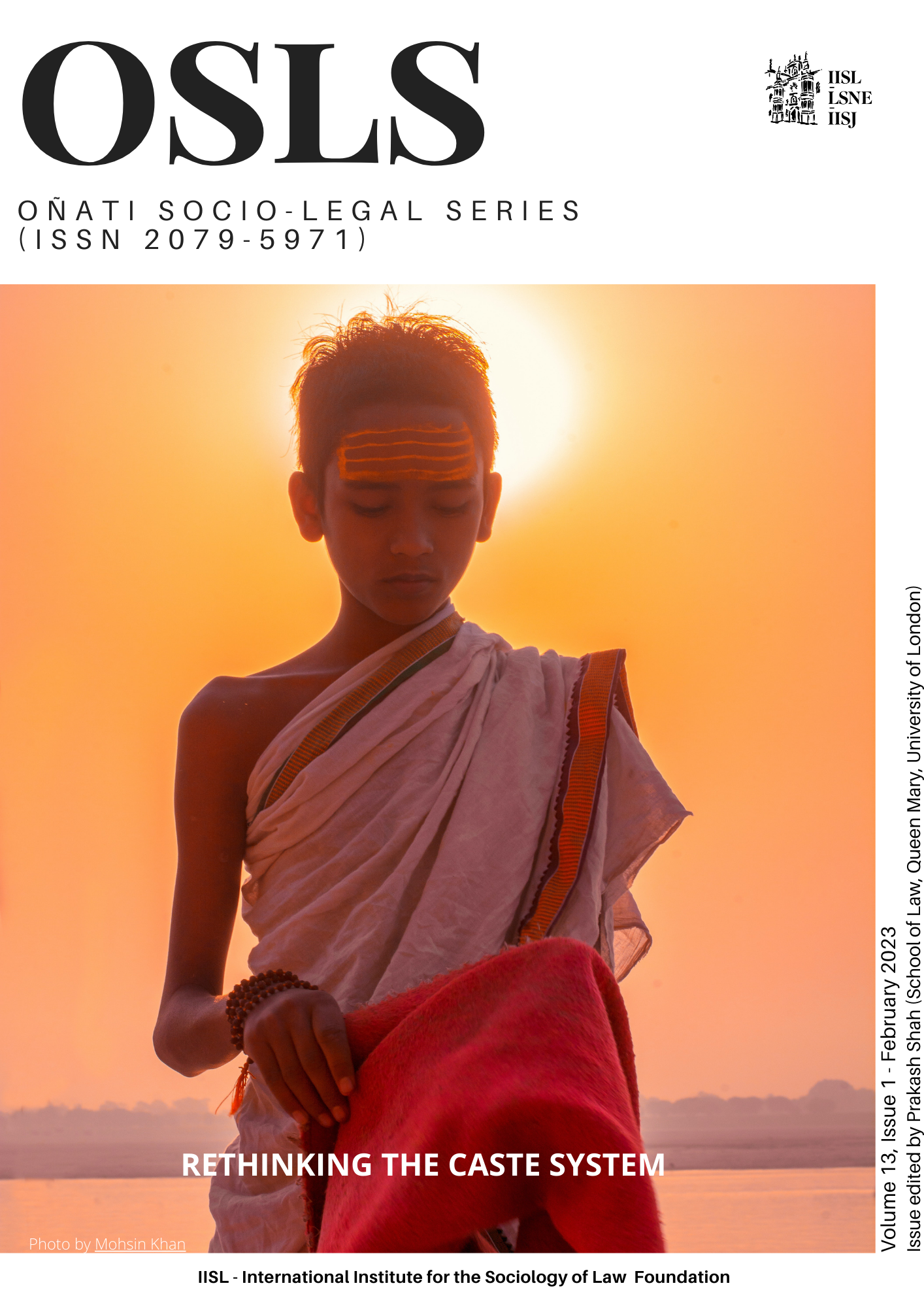Evolution of the figure of the Brahmin in early Muslim writings
DOI:
https://doi.org/10.35295/osls.iisl/0000-0000-0000-1318Palavras-chave:
Al-Biruni, Brahmin, brahmanism, indology, India, Islam, medieval India, caste systemResumo
When we talk about the caste system today, among other things, we talk about the wily, crafty and the boasting Brahmins who founded and maintained a set of self-serving rules that effectively took the form of the caste system. How do social scientists know about these Brahmins? As a set of new scholars are demonstrating today, the ancient Indian texts - such as the Vedas or the Mahabharata - do not talk about the caste system or the rule-setting priestly class of Brahmins. These texts do not even exhibit an impulse to put into place a system that even remotely resembles the so-called caste system. Whence is this idea of Brahmin then? Ever since Wilhelm Halbfass’s Imagining India (1990), a growing but a small number of Indologists talk about the 11th century Al-Bīrūnī as one of “the greatest scholars ever” to speak about the Indian caste system. There is, however, neither a comprehensive study to show what his contributions measure up to nor any attempt to dig into the Islamic culture that culminates in Al-Biruni’s quite detailed picture of the Brahmin and the caste system. This paper sifts through the earliest available Islamic writings on India, from the early 8th century to Al-Biruni’s time, to chart a genealogy of the figure of the law-making crafty Brahmin that we confront by the 11th century in Muslim writings.
Downloads
Metrics
Estatísticas globais ℹ️
|
2087
Visualizações
|
4066
Downloads
|
|
6153
Total
|
|
Referências
Abrahamov, B., 1987a. Al-Ḳāsim Ibn Ibrāhīm’s Theory of the Imamate. Arabica [online], 34(1), 80–105. Available from: https://doi.org/10.1163/157005887X00351 [Access 31 August 2021]. DOI: https://doi.org/10.1163/157005887X00351
Abrahamov, B., 1987b. The Barāhima’s Enigma: A Search for a New Solution. Die Welt des Orients, 18, 72–91.Ahmad, S.M., trans., 1989. Arabic Classical Accounts of India and China. Shimla: Indian Institute of Advanced Study.
Al-Jawzi, I., 2014. The Devils Deceptions: Being a Translation of his Masterpiece “Talbis Iblis”. Birmingham: Dar as-Sunnah.
Asif, M.A., 2016. A Book of Conquest: The Chachnama and Muslim Origins in South Asia [online]. Cambridge, MA: Harvard University Press. Available from: https://doi.org/10.4159/9780674972414 [Access 21 August 2021]. DOI: https://doi.org/10.4159/9780674972414
Ataman, K., 2005. Re-reading al-Birūnī’s India: A Case for Intercultural Understanding. Islam and Christian-Muslim Relations, 16(2), 141–154. DOI: https://doi.org/10.1080/09596410500059623
Balagangadhara, S.N., 2005. “The Heathen in his Blindness...” Asia, the West, and the Dynamic of Religion. 2nd ed. Delhi: Manohar.
Balagangadhara, S.N., 2012. Reconceptualizing India Studies. New Delhi: Oxford University Press.
Balagangadhara, S.N. (with S. Rao), 2021. What Does It Mean to Be “Indian”? Chennai: Notion Press.
Bosworth, C.E., 1977. Al-Ḫwārazmī on Theology and Sects: The Chapter on Kalam in the Mafātīḥ Al-ʿUlūm. Bulletin d’études orientales, 29, 85–95.
Calder, N., 1994. The Barāhima: Literary Construct and Historical Reality. Bulletin of the School of Oriental and African Studies [online], 57(1), 40–51. Available from: https://doi.org/10.1017/S0041977X00028093 [Access 21 August 2021]. DOI: https://doi.org/10.1017/S0041977X00028093
Dodge, B., ed., 1970. The Fihrist of Al-Nadim: A Tenth-Century Survey of Muslim Culture [Vol 1 and 2]. New York: Columbia University Press.
Friedmann, Y., 1975. Medieval Muslim Views of Indian Religions. Journal of the American Oriental Society [online], 95(2), 214–221. Available from: https://doi.org/10.2307/600318 [Access 21 August 2021]. DOI: https://doi.org/10.2307/600318
Friedmann, Y., 1977. A Contribution to the Early History of Islam in India. In: M. Rosen-Ayalon, ed., Studies in Memory of Gaston Wiet. Jerusalem: Institute of Asian and African Studies, 309–333.
Gordon, M.S., et al., eds., 2018. The Works of Ibn Wāḍiḥ al-Yaʻqūbı̄: An English Translation [online], 3 Volumes. Leiden: Brill. Available from: https://doi.org/10.1163/9789004364158 [Access 21 August 2021]. DOI: https://doi.org/10.1163/9789004364158
Hahn, T., 1978. The Indian Tradition in Western Medieval Intellectual History. Viator: Medieval and Renaissance Studies, 9, 213–234. DOI: https://doi.org/10.1484/J.VIATOR.2.301547
Halkin, A.S., trans., 1935. [Al-Baghdādī’s] Moslem Schisms and Sects (Al-Fark Bain Al-Firak) Being the History of the Various Philosophic Systems Developed in Islam... Part II. 1978 Reprint. Philadelphia: Porcupine Press.
Haque, S.M., 1987. Ibn an-nadim on Religious Sects in Ancient India. PhD thesis. University of Calcutta.
Harshe, R.G., 1941. Arabic Version of the Mahābhārata Legend. Bulletin of the Deccan College Research Institute, 2(3/4), 314–324.
Hawting, G.R., 2006. The Idea of Idolatry and the Emergence of Islam: From Polemic to History. Cambridge University Press.
Hayes, E., 2017. Early Islamic Cosmopolitanism? Constructing the ʾUmma of India in Pre-Mongol Muslim Scholarship. Comparative Islamic Studies [online], 13(1–2), 75–120. Available from: https://doi.org/10.1558/cis.32620 [Access 11 August 2021]. DOI: https://doi.org/10.1558/cis.32620
Hillenbrand, R., 2016. The Edinburgh Biruni Manuscript: A Mirror of Its Time? Journal of the Royal Asiatic Society, 26(1–2), 171–99. DOI: https://doi.org/10.1017/S1356186316000018
Jafri, R.S., 1960. Description of Hind and Sind as Given by Al-Istakhri, Ibn Hauqal & Al-Maqdisi. M.A. Thesis. Aligarh Muslim University.
Jalki, D., 2018. Caste as an Impediment in the Journey of a Bhakta: Lingayat Vachanas, Jati and Adhyatma. In: V. Rao, ed., Critical Humanities from India: Contexts, Issues, Futures. New York: Routledge, 149–176. DOI: https://doi.org/10.4324/9781351234948-7
Kozah, M., 2015. The Birth of Indology as an Islamic Science: Al-Bīrūnī’s Treatise on Yoga Psychology. Leiden: Brill. DOI: https://doi.org/10.1163/9789004305540
Kraus, P., and Vajda, G., 1971. Ibn al-Rāwandī or al-Rēwendī. In: P. Bearman et al., eds., The Encyclopaedia of Islam: H-Iram. Leiden: Brill.
Lawrence, B.B., 1973. Shahrastānī on Indian Idol Worship. Studia Islamica, (38), 61–73. DOI: https://doi.org/10.2307/1595309
Lawrence, B.B., 1976a. Al-Biruni’s Approach to the Comparative Study of Indian Culture. In: E. Yarshater, ed. Biruni Symposium. New York: Iran Center, Columbia University, 27–48.
Lawrence, B.B., 1976b. Shahrastani on the Indian Religions. The Hague: De Gruyter Mouton.
Leaman, O., 2006. Al-Shafi’i, Muhammed b. Idris. The Qur’an: an Encyclopedia. London: Routledge.
Lindstedt, I., 2011. Anti-Religious Views in the Works of Ibn al-Rāwandī and Abū l-ʿAlāʾ al-Maʿarrī. Studia Orientalia, 3, 131–158.
Louër, L., 2020. Sunnis and Shi’a: A Political History. Princeton University Press. DOI: https://doi.org/10.2307/j.ctvp2n4ft
Maclean, D.N., 1984. Religion and Society in Arab Sind. PhD Thesis. Montreal: McGill University.
Marks, R.G., 2007. Hindus and Hinduism in Medieval Jewish Literature. In: N. Katz et al., eds., Indo-Judaic Studies in the Twenty-First Century: A View from the Margin. New York: Palgrave Macmillan, 57–73. DOI: https://doi.org/10.1057/9780230603622_4
Marlow, L., 1995. Some Classical Muslim Views of the Indian Caste System. The Muslim World [online], 85(1–2), 1–22. Available from: https://doi.org/10.1111/j.1478-1913.1995.tb03607.x [Access 10 August 2021]. DOI: https://doi.org/10.1111/j.1478-1913.1995.tb03607.x
Martin, R.C., 1980. The Role of the Basrah Muʿtazilah in Formulating the Doctrine of the Apologetic Miracle. Journal of Near Eastern Studies [online], 39(3), 175–189. Available from: https://doi.org/10.1086/372801 [Access 10 August 2021]. DOI: https://doi.org/10.1086/372801
Minorsky, V., 1942. Sharaf Al-Zamān Tāhir Marvazī on China, the Turks and India. London: The Royal Asiatic Society.
Minorsky, V., 1948. Gardīzī on India. Bulletin of the School of Oriental and African Studies, University of London, 12(3/4), 625–640. DOI: https://doi.org/10.1017/S0041977X00083191
Nadvi, S., 1934. Religious Relations between Arabia and India [Part 1 and 2]. Islamic Culture, the Hyderabad Quarterly Review, 8, 120–139, 200–211.
Olivelle, P., 2005. Manu’s Code of Law. Oxford University Press. DOI: https://doi.org/10.1093/oso/9780195171464.001.0001
Papaconstantinou, A., 2008. Between Umma and Dhimma: The Christians of the Middle East under the Umayyads. Annales Islamologiques [online], 42, 127–56. Available from: https://www.ifao.egnet.net/anisl/42/7 [Access 15 August 2021].
Pines, S., 1971. A Note on an Early Meaning of the Term Mutakallim. Israel Oriental Studies, 1, 165–251.
Pines, S., 1980. Appendix I: A Doctrine of the Brahmans (Barahima) according to Al-Qasim b. Ibrahim and Saadia Gaon. Jerusalem Studies in Arabic and Islam, 2, 220–223.
Price, E.G., 2015. The Medicine of the Prophets: Maṣlaḥa in the Baṣran Mu’tazilī Defence of Prophecy and the Revealed Law. M. Phil. thesis. Oxford University.
Price, E.G., 2017. Rationalising Ritual: Responses to Antinomian Anxiety in the Era of Abbasid Fragmentation (A Conference Paper). Magic and the Occult in Islam & Beyond: International Symposium. Yale University.
Rahman, F., 1986. Barāhima. In: P. Bearman et al., eds., Encyclopaedia of Islam, New Edition, Vol. 1, A-B. Leiden: Brill, 1031.
Robinson, C.F., 2003. Islamic Historiography. Cambridge: Cambridge University Press.
Rosenthal, F., ed., 1989. The History of al-Tabari (Ta’rikh al-rusul wa’l-muluk): Volume I, General Introduction and from the Creation to the Flood. Albany: State University of New York Press.
Sachau, E.C., ed., 1910a. Alberuni’s India: An Account of the Religion, Philosophy, Literature… Vol. 1. London: Kegan Paul.
Sachau, E.C., ed., 1910b. Alberuni’s India: An Account of the Religion, Philosophy, Literature... Vol. 2. London: Kegan Paul.
Schimmel, A., 1975. Turk and Hindu: A Poetical Image and Its Application to Historical Fact. In: S. Vryonis Jr., ed., Islam and Cultural Change in the Middle Ages. Wiesbaden: Otto Harrassowitz, 107–126.
Schmidt, F., 1994. Between Jews and Greeks: The Indian Model. In: H. Goodman, ed., Between Jerusalem and Benares: Comparative Studies in Judaism and Hinduism. Albany: State University of New York Press, 41–54.
Shastri, A.M., 1975. Sanskrit Literature Known to Al-Biruni. Indian Journal of History of Science, 10(2), 111–138.
Sprenger, A., trans., 1841. El-Mas’udi’s Historical Encyclopaedia: Entitled “Meadows of Gold and Mines of Gems” (Vol. 1). London: Oriental Translation Fund.
Stroumsa, S., 1985a. The Barahima in Early Kalam. Jerusalem Studies in Arabic and Islam [online], 6, 229–241. Available from: https://www.academia.edu/37023578/Sarah_Stroumsa_The_Bar%C4%81hima_in_Early_Kalam_Jerusalem_Studies_in_Arabic_and_Islam_6_1985_229_241 [Access 12 August 2021].
Stroumsa, S., 1985b. The Signs of Prophecy: The Emergence and Early Development of a Theme in Arabic Theological Literature. The Harvard Theological Review [online], 78(1/2), 101–114. Available from: https://doi.org/10.1017/S0017816000027401 [Access 31 August 2021]. DOI: https://doi.org/10.1017/S0017816000027401
Stroumsa, S., 1989. Dawud Ibn Marwan Al-Muqammis’s Twenty Chapters: (ʻIshrūn Maqāla). Leiden: Brill. DOI: https://doi.org/10.1163/9789004451193_009
Stroumsa, S., 1994. The Blinding Emerald: Ibn al-Rāwandī’s Kitāb al-Zumurrud. Journal of the American Oriental Society, 114(2), 163–185. DOI: https://doi.org/10.2307/605828
Stroumsa, S., 1999. The Pagan Legacy of Freethinkers of Islam. In: S. Stroumsa, Freethinkers of Medieval Islam: Ibn Al-Rawāndī, Abū Bakr Al-Rāzī and Their Impact on Islamic Thought. Leiden: Brill, 142–167. DOI: https://doi.org/10.1163/9789004452848_008
Stroumsa, S., 2007. Soul-searching at the Dawn of Jewish Philosophy: A Hitherto Lost Fragment of al-Muqammas’s Twenty Chapters. Ginzei Qedem, 3, 137–161.
Stroumsa, S., 2020. Logic as Interconfessional Weapon in the Early Islamicate World: Manṭiq, Qiyās, Kalām. The Journal of Eastern Christian Studies, 72(3/4), 181.
Van Ess, J., 1975. The Beginnings of Islamic Theology. In: J.E. Murdoch and E.D. Sylla, eds., The Cultural Context of Medieval Learning. Dordrecht: D. Reidel, 87–103. DOI: https://doi.org/10.1007/978-94-010-1781-7_4
Van Ess, J., 2018a. Al-Fārābī and Ibn al-Rāwandī. In: H. Biesterfeldt, ed., Kleine Schriften: Collected Short Writings of Josef van Ess (Volume 1). Leiden: Brill, 1369–1380. DOI: https://doi.org/10.1163/9789004336483_093
Van Ess, J., 2018b. Ibn ar-Rēwandī, or the Making of an Image. In: H. Biesterfeldt, ed., Kleine Schriften: Collected Short Writings of Josef van Ess (Volume 1). Leiden: Brill, 1342–1368. DOI: https://doi.org/10.1163/9789004336483_092
Verdon, N., 2015. Al-Bīrūnī’s Kitāb Sānk and Kitāb: Pātanğal: A Historical and Textual Study [online]. PhD Thesis. 16 December. University of Lausanne. Available from: https://serval.unil.ch/resource/serval:BIB_779D64E820E1.P001/REF [Access 20 August 2021].
Waardenburg, J., 1999. Muslim Studies of Other Religions. In: J. Waardenburg, ed., Muslim Perceptions of Other Religions: A Historical Survey. New York: Oxford University Press, 1–102.
Yaqub, A.M., trans., 2013. Al-Ghazali’s Moderation in Belief: al-Iqtisad fi al-i’tiqad. University of Chicago Press.
Publicado
Como Citar
Edição
Seção
Licença
Copyright (c) 2022 Dunkin Jalki

Este trabalho está licenciado sob uma licença Creative Commons Attribution-NonCommercial-NoDerivatives 4.0 International License.
OSLS strictly respects intellectual property rights and it is our policy that the author retains copyright, and articles are made available under a Creative Commons licence. The Creative Commons Non-Commercial Attribution No-Derivatives licence is our default licence and it regulates how others can use your work. Further details available at https://creativecommons.org/licenses/by-nc-nd/4.0 If this is not acceptable to you, please contact us.
The non-exclusive permission you grant to us includes the rights to disseminate the bibliographic details of the article, including the abstract supplied by you, and to authorise others, including bibliographic databases, indexing and contents alerting services, to copy and communicate these details.
For information on how to share and store your own article at each stage of production from submission to final publication, please read our Self-Archiving and Sharing policy.
The Copyright Notice showing the author and co-authors, and the Creative Commons license will be displayed on the article, and you must agree to this as part of the submission process. Please ensure that all co-authors are properly attributed and that they understand and accept these terms.






















